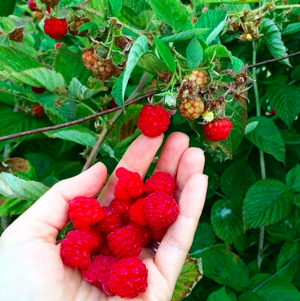
Raspberries (Rubus genus, rose family) are often considered to be the king of the berries, beloved by many people, and the birds. It is a perennial plant, with woody stems.
Description[edit | edit source]
While most raspberries are red, there are also black, white and yellow raspberry varieties. The red raspberries are the most cold-hardy and prefer a cooler summer, while black varieties aren't as cold tolerant but can handle more heat during summer.
Growing raspberries[edit | edit source]
Choose bareroot plants that have been certified disease free. Plant in the early spring.
Raspberries can grow very lushly and produce wonderful fruit in a rich, moist, heavily mulched soil (pea straw makes for a great mulch). They send out suckers which can find their way through the mulch, but the mulch offers protection from weeds, keeps the soil moist, and enriches the soil. However, this sucker behaviour is precisely the reason you would do well to find a special patch for the raspberries, well away from your vegetable patch unless you're keen on fighting suckers underneath the veggies.
Raspberries like rotted chicken manure for a regular feed.
In cooler areas, raspberries will grow well in full sun. In warmer areas, they will appreciate a little shade as well as a lot of sun.
Problems[edit | edit source]
Raspberries like to spread. You can control this spread by using rows for planting. Plant in rows, then dig out the additional suckers regularly. This prevents the spread and allows the remaining plants to grow well.
Uses for raspberries[edit | edit source]
Raspberries are a soft, easily damaged fruit - for this reason they are best home-grown (eaten before they can be damaged) or made into conserves to preserve the flavor and richness.
They also make a great sorbet and are delicious turned into a dessert sauce (coulis) to serve on puddings, cheesecake or ice cream.
Of all the berries, raspberries are the ones most associated with romantic food, from raspberry chocolates to raspberry champagne. This is most likely on account of the taste and the deep red colour.